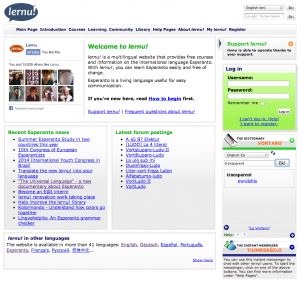How to get started with Esperanto Posted by Chuck Smith on May 2, 2014 in Uncategorized
So, I’m hearing back from the first people starting on their quest for the Esperanto Six Week Challenge. Start learning Esperanto now and in six weeks give a lecture in it. For more details, see my blog post: Learn Esperanto and win a free vacation! Basically, people are seeing all the resources out there and are wondering what are some of the best ways to start, here are my personal tips!
Lernu.net
Lernu.net is absolutely still the best reference… and I’d say nothing comes close for self-learning. I personally learned with the simple 10-lesson email course and I now wouldn’t recommend it, but at the time it was the best thing around! So, in the past ten years, I see lernu has become a bit bloated and it can sometimes be hard to get around. Luckily there are multiple beginner courses there, since one method won’t suit everyone. Here is a summary of lernu’s beginner courses to figure out what will suit you best. I typically recommend Ana Pana first.
- Ana Pana is a dialog-based course
- Bildoj kaj demandoj (Pictures and Questions) is good if you like a direct method approach without seeing your native language.
- Mi estas komencanto (I am a beginner) if you’re more of an auditory learner… just download and listen to the mp3s provided.
- La puzlo Esperanto is recommended if you want to learn Esperanto like solving a puzzle.
Books
If you want to learn from a book, I’d recommend the Katrina series to start. You can learn more about various beginner books at Lernu.net along with sample chapters to make sure you like it before you buy. I’d say start with Detektivu pri la krimo de Katrina.
Listening
For general listening comprehension, I’d highly recommend the podcasts by Radio Verda. They are spoken quite slowly and you can read the text as you listen to each episode. Also, they cover interesting, modern topics. When you want to listen to more natural speech and music to get a feel for that, I’d recommend the 24-hour radio station Muzaiko. Since there’s only one 24-hour station in Esperanto, they play a large variety of music, so if you don’t like something, the next piece might be very different or it might segue into an interview.
Inspiration
If you have any more questions, just leave a comment here and our helpful community (or myself) can get back with you with more recommendation. Also, feel free to engage with us on Facebook and we’ll help you getting started! For more inspiration, see which challenge Benny Lewis (the Irish Polyglot) is embarking on next:

Build vocabulary, practice pronunciation, and more with Transparent Language Online. Available anytime, anywhere, on any device.
About the Author: Chuck Smith
I was born in the US, but Esperanto has led me all over the world. I started teaching myself Esperanto on a whim in 2001, not knowing how it would change my life. The timing couldn’t have been better; around that same time I discovered Wikipedia in it’s very early stages and launched the Esperanto version. When I decided to backpack through Europe, I found Esperanto speakers to host me. These connections led me to the Esperanto Youth Organization in Rotterdam, where I worked for a year, using Esperanto as my primary language. Though in recent years I’ve moved on to other endeavors like iOS development, I remain deeply engrained in the Esperanto community, and love keeping you informed of the latest news. The best thing that came from learning Esperanto has been the opportunity to connect with fellow speakers around the globe, so feel free to join in the conversation with a comment! I am now the founder and CTO of the social app Amikumu.




